There has always been a lot of discussion in the industry about the need for air filtration in a pneumatic application. In a ideal world, there wouldn’t be any oil, particulate, water or other contaminants in your compressed air, but we know this is not the case. A pneumatic filter is a critical system component that can prevent premature failure of your pneumatic components.
Here are the major types of air filtration used in the industry, as well as how you can properly implement the right pneumatic filter for your application.
Water Separators
Water separators remove water particles from your compressed air by using an internal spinning mechanism.
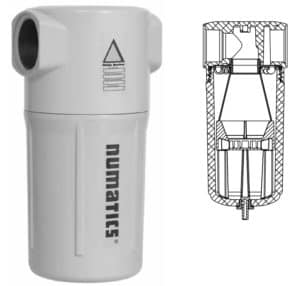
How Does Water Get into my Compressed Air?
It is normal for your industrial air supply to have water because it is a normal result in the production of compressed air. The air compressor draws in ambient air with a certain level of humidity (very high levels if you are here in Florida). When the air is compressed, this vapor becomes more concentrated, further raising the humidity level.
Compressed air with almost 100% humidity then leaves the air compressor, it cools, and water condenses inside your industrial air supply.
Particulate Filters
A particulate filter typically has a pleated design to maximize the surface area and to capture particulates as small as 3 microns. This maximizes the air flow necessary for your pneumatic application.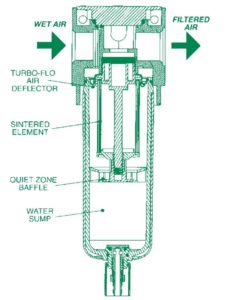
How Does Particulate Get into my Compressed Air?
Rust from old carbon steel pipes, dust from desiccant air dryers, and debris from compressor air intakes can all contribute to depositing particulate into your industrial air supply.
Coalescing Filters
Coalescing filters are the next defense for your pneumatic components. Smaller dust particles, water, and oil can still be present in your compressed air.
The construction of these coalescing filters varies from manufacturer to manufacturer, but they all work to consolidate the liquids into droplets to be drained out of the system. There are different grades of coalescing filters depending on where they are deployed in your application. Coarse coalescing filters are mainly used on your air supply’s main feed, whereas an ultra-fine coalescing filter is typically implemented at the point of use.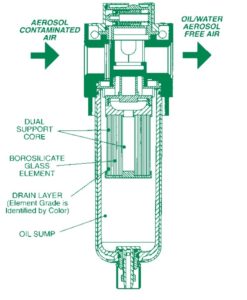
How Does Oil Get into my Compressed Air?
Typically, an air compressor uses oil to lubricate its moving parts which can make its way into your industrial air supply.
Even if you are using an oil free air compressor, you still have oil present because atmospheric air also contains oil vapor from sources such as car exhausts and industrial processes. When the atmospheric air is pulled through the air compressor intake, it becomes more concentrated (similar to the previous water example), and is added to your compressed air.
In some applications, oil is added to the industrial air supply to lubricate components. In other systems, this is not the case. Small amounts of oil present in the compressed air can breakdown leaving varnish as a residue. This can cause pneumatic components to stick or seize.
Adsorbing filters
An adsorbing filter (yes, adsorbing – not absorbing), removes oil and hydrocarbon vapor from the system. These are typically used in systems that require breathing air or air that contacts food or drug products.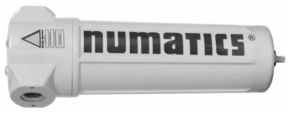
Which Air Filtration Should I Use for My Pneumatic Application?
Now that you understand why you need air filtration, which type of these filter elements do you need for your application?
The major considerations of which type of pneumatic filter you need should be:
- Environment Including Contaminants Present
- Industry Specific System Requirement
- Pneumatic performance
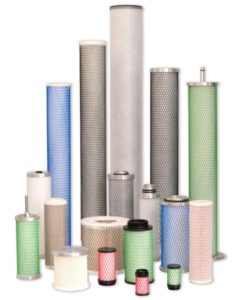 Here are some common examples of effective filter element combinations for particular industries that were provided in a Numatics Whitepaper.
Here are some common examples of effective filter element combinations for particular industries that were provided in a Numatics Whitepaper.
- Filter elements for blow molding — 3-micron particulate filter; 0.01-micron fine coalescing filter; adsorbing filter.
- Filter elements for electronics — 3-micron particulate filter; 1-micron coarse coalescing filter; 0.01-micron ultra fine coalescing filter.
- Filter elements for food packaging — 3-micron particulate filter; 0.01-micron fine coalescing filter; adsorbing filter.
- Filter elements for pneumatic control system — 3-micron particulate filter; 0.01-micron fine coalescing filter.
- Filter elements for process air — 1-micron coarse coalescing filter; 0.01-micron fine coalescing filter; adsorbing filter.
- Filter elements for semiconductor packaging – 3-micron particulate filter; 0.01-micron fine coalescing filter; adsorbing filter.
As you can see, there’s quite a bit that goes into choosing the right filter combination for your particular application. Hopefully, this guide has given you a good place to start but if you need more information, the pneumatics experts at Cross Company would be glad to help!
